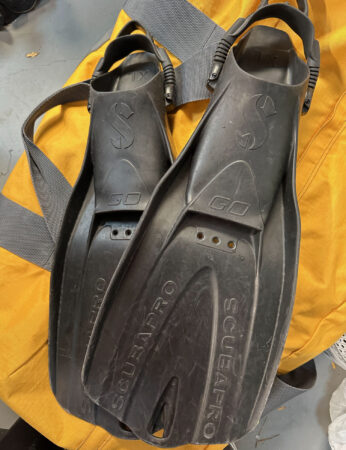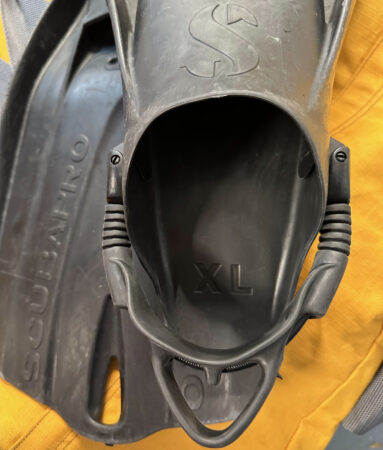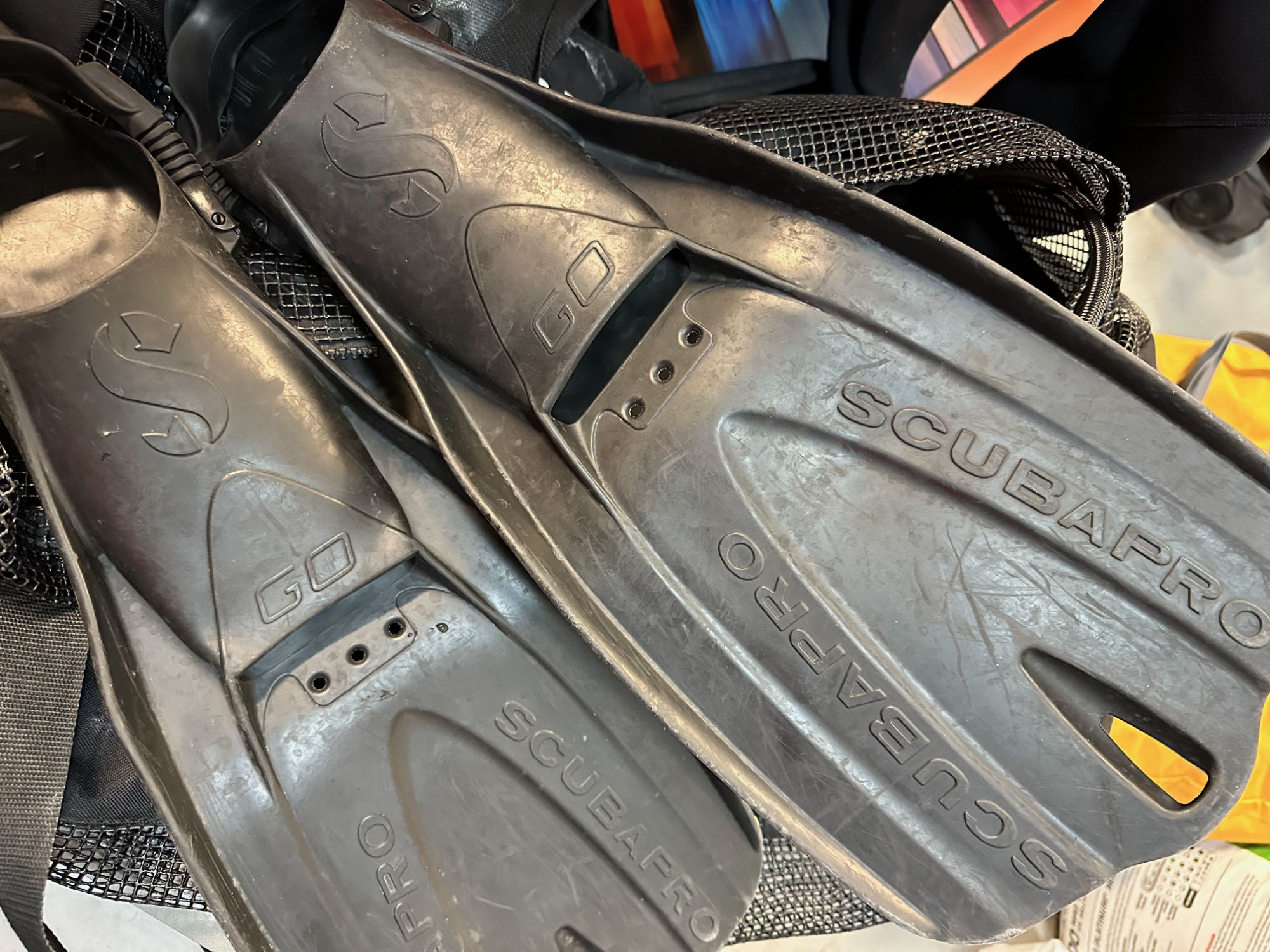Scubapro Go Fins
If you look over my dive gear reviews, you may notice most (not all) of my reviews are positive. That’s because I review scuba gear that I personally own and dive. Every one of my scuba gear reviews is 100% honest, and I really have nothing to gain by writing them. Rather than bash on dive gear I don’t like, I prefer to spread the word about dive gear that’s really good.
All that is true with the Scubapro Go Fins review that’s about to follow. For years, I had been diving with long-discontinued, Apollo Prestige dive fins. Later, when Dive Rite (Dive Rite bought the original molds from Apollo) finally got the material right (Monprene®), I switched to Dive Rite XT fins.
The downside to both is that the largest sizes (required to accommodate drysuit boots) have huge, stiff blades. Underwater, they work well. You can finesse your body position with tiny fin movements. But, long surface swims, especially in a drysuit, carrying cameras, etc. are miserable. I’m pretty fit and have better than average leg strength and endurance. As much as it deflates my ego to admit it, I can’t easily push those giant fin blades on surface swims.
Enter the Scubapro Go Fin
 I purchased my first pair of Scubapro Go Fins about 5 years ago. I wanted a fin that was made of Monprene and wouldn’t require a boot. Before Go Fins, the only options I was aware of were full-foot fins or way undersized “normal” diving fins. Neither was a good option.
I purchased my first pair of Scubapro Go Fins about 5 years ago. I wanted a fin that was made of Monprene and wouldn’t require a boot. Before Go Fins, the only options I was aware of were full-foot fins or way undersized “normal” diving fins. Neither was a good option.
I don’t know how I got introduced to Scubapro Go Fins. It must have been someone at Sierra Diving Center where I teach. I needed a lightweight travel dive fin for an upcoming marketing assignment for a dive resort in Roatan. I hate traveling with regular dive boots. They are unnecessarily bulky, weigh a lot, and never seem to dry out between dives. They stink…. in all ways.
Scubapro Go Fins are great because you can get away with diving them barefooted. I do it every week teaching classes in the pool. I’ve done many week long dive trips where I did every dive in bare feet. However, I do find them to be more comfortable wearing neoprene socks, with or without thin soles.
Diving barefoot doesn’t work all that great if you have to walk over sharp rocks, etc. to get to the water. For that, I sometimes wear Tevas into the water and clip them to a d-ring after I put my fins on.
My First Pair of Scubapro Go Fins
When I bought my first pair of Scubapro Go Fins, I was not aware that they were actually Go Travel Fins. It is possible I simply didn’t realize there was also a “Go Sport Fin,” but, in any case, I had (still have) the smaller ones.
I left the store and went home to pack for Roatan before flying out the next morning. The weight and space savings is amazing. It would be about 40 hours before I’d learn what it is like to dive with Go Fins, but if you are looking for travel scuba gear, they are definitely travel-friendly.
Scubapro Go Fins in the Water
Scubapro Go Fins are light, affordable and made using the right material. Great, but, what’s it like to dive the Go Fin?
I was pretty excited to get my new Go Fins in the water. Since I usually carry a lot of bulky camera equipment, getting my dive gear to the boat is almost secondary. I bring as little as possible. If diving back-mount , open circuit, I have a lightweight aluminum plate and a minimal lift wing. For sidemount, my travel harness and wing are even smaller and lighter. Since my Go Fins don’t require boots, all I have left is my mask and dive computers. On the first several dives, I felt like I was forgetting something.
On this trip, we were working for a very remote, small dive resort. I was on the smaller of two small boats. That made keeping compact even more convenient.
After a back roll entry, the captain handed down my camera and I was off. My first impressions of the Scubapro Go Fins were:
- With bare feet, Go Fins feel somewhat less secure than I am used to. I could probably size down a little, but I didn’t find it to be a problem anyway.
- Also, it’s odd feeling the cool water when you are used to wearing boots. But, these both are more about diving barefooted than something to do with Go Fins themselves.
- Scubapro Go Fins have perfect blades. They are more flexible than many other fins, but I there is no issue with power at all. At least not for me. And, if you currently dive split fins, I suspect you’ll like Go Fins better. I don’t dive with split fins because I find them difficult to finesse when I need to hold a position with my camera.
- Go Fins are great for frog kicking, finning backwards and for keeping a camera still when there is water movement.
- The Go Fins heel straps are similar to spring straps, but with bungee, which I love. It the same for most Scubapro dive fins.
- Scubapro Go Fins are nearly neutrally buoyant in the water. Just very slightly positive.
- There is no shortage of power with Scubapro Go travel fins, in spite of how light and compact they are. Most divers don’t need much power anyway, and will never have a reason to give it a thought.
- With a neoprene sock, Go Fins feel like any other dive fin. If you want to dive with a boot, the Scubapro Go Sport Fin is ideal.
Scubapro Go Sport Fins
 I had been traveling at least a year with Go Fins before I learned that there are two versions. I was teaching an Open Water class in Lake Tahoe when I noticed another instructor had them.
I had been traveling at least a year with Go Fins before I learned that there are two versions. I was teaching an Open Water class in Lake Tahoe when I noticed another instructor had them.
It’s embarrassing because for months I had been wishing such a thing existed. We traded fins for the next dive. The Go Sport fin was just what I had hoped for. The blade is proportionately larger than the travel fin blade as you would expect, but not huge, and made of the Monprene material.
The flex is perfect and the straps are the same. Basically, Scubapro scaled up the fin to handle larger boot sizes without making the blades uncomfortable to kick. I think this is where a lot of dive fin manufacturers get it wrong. Accommodating a larger boot size doesn’t always mean the diver needs or wants a gigantic fin blade.
I usually dive with a DUI TLS drysuit with Rock Boots. It obviously takes a roomy foot pocket to accommodate the larger boot. An overly huge fin blade would have completely changed the way the fin feels in the water. It would have ruined it in my view.
As they designed them, they are just large enough to pair perfectly with the increased drag caused by diving dry.
I have been diving with Go Fins exclusively for about three years, maybe four. Teaching over the weekend, I noticed almost every instructor was diving Scubapro Go Sport fins. Before the Go Sport, most of those instructors would have been using split fins. I was still using Dive Rite XT fins at that time.
The majority of students were in Go Fins too, but they chose them based on recommendations, rather than through experience.
Scubapro Go Travel and Scubapro Go Sport Dive Fins
For me, Scubapro Go Fins are about as perfect as it gets. They are comfortable and work well for every type of diving. They also resist abrasion better than most other “plastic” fins. Monprene is rubbery. It doesn’t scratch as easily as other materials, but isn’t heavy like real rubber. There is also nothing that can delaminate, so Go Fins are practically unbreakable.
Being a complete dive gear junkie, I’ll always be on the lookout for the next “best dive fins”, but for now, I can’t imagine there is one. Let me know what you think.



Hi Joe! I was just wondering out of the 2 fins what the biggest difference is between them besides the length. I’m thinking of switching to these but until I read your review I also did not realize there were 2 types. My biggest concern I think is how well do they hold up in a stronger current with the shorter length? My one friend uses the travel ones and she felt that they weren’t as good with a current as her longer oceanic. Since you have used both I was wondering what your thoughts were.
Hi Jaymi! The Sport version of the Scubapro Go Fin is longer and a little wider, but the biggest difference is the foot pocket. The whole fin is proportionately larger than the travel version, but the Sport works with cold water boots, including drysuit boots like the DUI Rock Boot.
As far as current is concerned, it depends. If you’re diving somewhere like Cozumel, which I have quite a lot, you never really swim against the current, so it doesn’t make much difference. On the other hand, if you need to swim against a heavy current, some divers may find the blades to be a little soft.
The trade off with a stiff, large blade is endurance. I used to use the Apollo Prestige, which later became the Dive Rite XT. Those are hard to push forcefully for a long time, so I finally made the switch.
If the choice comes down to the Go Sport vs the Go Travel fin, it really gets down to what boots you’ll be wearing. Heavy, thick soles require the larger foot pocket. That’s why I have both. I actually have two pairs of Go Travel Fins and one Sport. I bought the second pair of travel fins because they are white. I actually white balance my video camera against my fin blades instead of carrying a white card.
Please let me know what you decide! – Joe